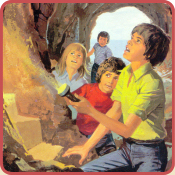
The Enid Blyton Nature Readers (No. 1)

Book Details...
First edition: 1945
Publisher: Macmillan
Illustrator: Eileen A. Soper
Category: The Enid Blyton Nature Readers
Genre: Nature
Type: Readers
Publisher: Macmillan
Illustrator: Eileen A. Soper
Category: The Enid Blyton Nature Readers
Genre: Nature
Type: Readers
On This Page...
- The Brownie's Magic
Story: Specially Written - The Friendly Robin
Story: Specially Written
Nature plates, illustrated by Eileen A. Soper


In 1949 'MacMillan & Co.' stated:

"This series of Enid Blyton Nature Readers, although apparently a collection of entertaining and amusing tales, is in reality something very much more. The sixty tales cover a vast range of Nature facts, and aim to give a clear and comprehensive review of the Science of Life in so far as it is understandable by young children."
That's fair enough, but whether or not one is a child, the 'collection of entertaining and amusing tales' can be enjoyed by anyone of any age, especially when illustrated by Eileen Soper who identifies very well with the Blyton Phenomenon.
The Brownie's Magic:
Bobbo the brownie emerges from his hillside cave to find there's been a heavy fall of snow and there, coming to visit him, is his clever cousin Brownie Bright-Eyes who's carrying something heavy. It's a mirror that Bright-Eyes has manufactured all by himself and he wastes no time telling Bobbo how clever he is to perform such a task; Bright-Eyes is a very boastful brownie. He leans the mirror up against a table and tells Bobbo to look into it, which he does, but all he can see is darkness with a kind of mist in front of it.
It turns out that you can't see your reflection but you can see where anyone is; for example let's enquire about Tippy the brownie. Where would he be? Bright-Eyes strokes the mirror softly and puts the question whereupon a picture appears of Tippy sitting in a bus.
However, Bobbo informs his cousin that he already knew Tippy was in a bus simply by using his brains. Bright-Eyes disbelieves him and reckons he fluked it so he asks Bobbo where Jinky the pixie might be.
To his amazement, Bobbo tells him.
"He's gone up the hill to see his aunt."
When Bright-Eyes rubs the mirror again, sure enough there's Jinky sitting, and talking to a plump old lady. How curious. Bobbo then informs his cousin that he could tell him all kinds of things that Bright-Eyes might find in his mirror, and he proceeds to let on that Red-Coat the fox passed by in the night, some rabbits and ducks have been around and about, not to mention that a few sparrows had flown down recently to peck at some crumbs Mother Jane had scattered for them. Bobbo is a mine of information and he goes on to tell Bright-Eyes news about Crek-Crek the moorhen, and Tippy's dog, and even his cow.
Bright-Eyes is nonplussed so he checks his mirror to see if Bobbo is correct and finds him right on all counts. Explanations just have to follow ... and they do.
Now how did Bobbo know that Tippy was on a bus?
The Friendly Robin
Billy and Susan's favourite visitor to their bird table is the red robin. He's a bold little bird and once he even tapped at their window with his beak when the children hadn't put any food out. Wintertime brings many feathered friends but when spring arrives, the free eats aren't all that necessary seeing there's plenty of edible stuff to be found in the bushes, hedges, and ditches.
Early in the season, Billy and Susan want to conduct a search to see if they can find the robin's nest but a problem occurs - they get the measles. Both are confined to bed, and boredom sets in when they become tired of playing with their toys and, as Mother's rather busy, she can't relieve the monotony by reading to them.
A welcome situation develops however when their little robin friend actually flies in the open window one day, curious as to why the children are no longer around. Billy and Susan are delighted as they watch him flapping about the room, mistaking his reflection in the mirror for another robin, and then flying out again. A thrilling period follows with the bird visiting and even warbling a few tuneful notes to entertain the children before making off and then, on his next visit, a second robin appears. Billy excitedly suggests to Susan that a nest may be in the offing because both birds examine the top of a cupboard minutely and, sure enough, bits of grass and dead leaves are hauled in that very day. The robins are building a home for themselves.
A decision is made.
This has to be kept a secret because we all know what a grown-up's attitude would be to rubbishy-looking things lying about on the tops of wardrobes. Over the next few days a nest is constructed and, as the children throw off their sickness, five eggs are laid by the hen-robin, which eventually hatch out into tiny fledglings. Billy and Susan have diligently kept their secret but then, just as things are going so swimmingly, the children receive a shock.
"I am going to have your bedroom spring-cleaned tomorrow."
There's a book entitled 'The Blyton Phenomenon' (c-1982). It contains a reasonably comprehensive account of the author's works plus an excellent list of references, if one can spare the time to look them up.
A quote inside the volume: Miss Blyton has written some hundred and fifty books and aims at a steady twenty a year. She is reported as saying, "It is like pulling cotton off a reel."
#1: A boastful attitude is a handy weakness with which to illustrate the author's penchant for balancing things out a little. There was once a girl called Brenda who boasted pretty well about everything until some brownies supplied an antidote; and a prince called Janni was eventually cured of his boastfulness by a mere washer-woman's children. Another lad called 'Bill' was also a boaster until the inevitable happened and his true colours were shown. ('Naughty Children' books).
Enid Blyton often referred to aunties, especially when a distraction was called for:
"I can't go before lunch," said Daisy. "Nor can Larry. We've got an aunt coming." (Holly Lane)
"Come on," said Daisy. "The train will be in. Fancy, we've had almost a week's holiday and haven't seen Bets and Pip. I bet they didn't like staying with their Aunt Sophie—she's frightfully strict and proper. (Pantomime Cat)
"Have you any secluded properties standing well back from the road?" asked Fatty in a smooth, dignified voice. "My aunt would like to hear of some. (Secret Room)
'It's tea-time,' said Fatty. 'We'd better go home. I've got an aunt coming. See you tomorrow!' (Spiteful Letters)
And then a new sound came to worry poor Mr. Goon. A voice came from somewhere, a groaning voice that said: "I never did it, I never! Ooooooh! I never did it! Where's my auntie?" (Strange Bundle)
Bobbo's claim about Red-Coat's recent presence could be worked out by any one of us who possesses a reasonable I.Q.
#2: In the days when this book was written, 'measles' was a very common ailment and most children seemed to get this disease. Blotches on one's skin and a sense of being 'washed out' was the name of the game and it lasted for several days.
There's a picture of Billy and Susan in bed with the friendly robin friend standing on their windowsill. Enid Blyton states the window is unfastened at the top but Eileen Soper's picture has it wide open at the bottom ... and why not? Fresh air is supposed to be good for sick children.
The cover picture is a 'wrap-a-round' one.
The 'sixty' tales referred to up top comprises the contents of thirty Nature Readers.







 Book 1 of 36 in this category
Book 1 of 36 in this category 